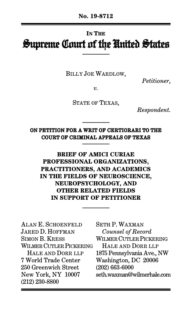JULY 2, 2020 – In six days, Billy Joe Wardlow is scheduled to be executed for a crime he committed at age 18. Wardlow’s defense team is asking the U.S. Supreme Court to stay the execution. CLBB’s neuroscience faculty provided the most up to date adolescent and emerging adult neuroscience data to supplement an amicus brief in this case, and CLBB was honored to be a signatory to the amicus brief as a whole. See below for details of this compelling case, and a description of the relevant neuroscience.
Should Billy Joe Wardlow be Executed for a Crime Committed When He Was Eighteen? Lincoln Caplan | The New Yorker | June 30, 2020
Background: Billy Joe Wardlow “was 18 years, 6 months, and 19 days old on June 14, 1993, the morning he and his girlfriend, Tonya Fulfer, set out to steal Carl Cole’s Chevy Silverado. In their minds the theft would be the first step toward a new life, one far from the parents who had hurt them and the poverty they’d known in rural Northeast Texas. The idea was to drive the pickup to Montana, change their identities, and begin life anew. The plan’s magical thinking revealed itself as Wardlow stood on Cole’s front porch at dawn. Wardlow asked to borrow a phone. Cole handed one through the door. As Wardlow pretended to make a call, Cole tried to shut the door. Wardlow brought out the .45 he’d stolen from his mother hours before. To Wardlow’s surprise, the 82-year-old Cole charged him, grabbed his arm, and began to push the much-larger Wardlow backwards off the porch. As Cole’s fingers grabbed for control of the gun Wardlow shot. Cole fell dead. Wardlow and Fulfer were arrested two days later, having made it as far as South Dakota.” (source: Austin Chronicle)

Highlight from The New Yorker essay: “With Wardlow’s execution scheduled for July 8th, the Supreme Court must rule before then on his request for a stay, perhaps this week. He wrote … in May: “I want to cause no more harm. I want to erase the pain I’ve inflicted on others. I want to be someone those I respect would be proud of. I want to be useful to those I love. I want to be someone others look up to and respect . . .I want to wipe away the taint of my past.'”

Amicus Brief to the U.S. Supreme Court
An amicus brief was submitted to the Supreme Court on behalf of professional organizations, practitioners, and academics in the fields of neuroscience, neuropsychology, and other related fields. Our neuroscience faculty at CLBB provided the most up-to-date adolescent and emerging adult neuroscience data to supplement the amicus brief. Neuroscience in Action: “In light of what science has now shown about the developing brain, there is a broad consensus in the neuropsychological community that it is impossible to determine whether an 18-year-old-even one that has committed an act of deadly violence-is likely to commit acts of violence as a mature adult. …in early adolescence, specific brain regions, notably the ventral striatum within the basal ganglia, mature in ways that promote reward- and sensation seeking, leading to riskier behavior. Recent, seminal neuroimaging studies show that a heightened sensitivity to rewards dominates adolescent decision-making. . . .
Research also shows that development of the amygdala between early adolescence and adulthood elevates the brain’s sensitivity to emotional triggers. In fMRI studies in which subjects were shown images of human faces in expressions of fear, researchers found that adolescents, relative to adults, exhibited a general pattern of “heightened amygdala activity and slower behavioral responses to fearful faces.” That finding suggests “increasing emotion regulation capacity from adolescence to adulthood” and “continued functional change from young childhood through early adulthood.” . . . In sum, new neuroimaging studies reveal that the prefrontal cortex-an area of the brain associated with reasoning and executive function- remains developmentally immature and underregulated until the mid20s, while the brain’s reward centers are relatively overexpressed, making emerging adults “more vulnerable to impulsivity,” less capable of emotional reasoning, and more likely to make “errors in self-regulation.”



